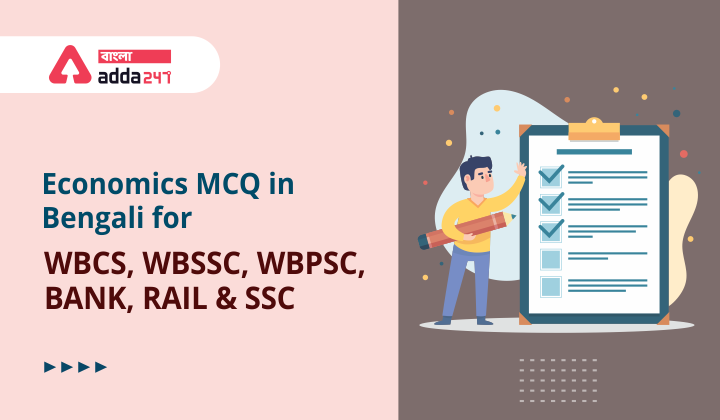Table of Contents
Economics MCQ in Bengali: Welcome to Adda 247. ADDA 247 Bengali is giving you Economics MCQ in Bengali for all competitive exams including WBCS Exam. Here you get Multiple Choice Questions and Answers with Solutions every day. Here you will find all the important questions and answers that will help you increase your knowledge and move you towards fulfilling your goals. Study these Economics MCQs regularly and succeed in the exams.
| Economics MCQ in Bengali | |
| Topic | Economics MCQ |
| Category | Daily Quiz |
| Used for | WBCS Exam |
Economics MCQ
Q1. এশিয়া-প্যাসিফিক ইকোনমিক কো-অপারেশন (APEC) এর সদর দপ্তর অবস্থিত
(a) চীন
(b) ভারত
(c) সিঙ্গাপুর
(d) হংকং
Q2. ভারতের পরিকল্পনা কমিশন কত সালে গঠিত হয়?
(a)1942.
(b)1947.
(c)1950.
(d)1955.
Q3. কোন পঞ্চবার্ষিক পরিকল্পনার মেয়াদ ছিল মাত্র চার বছর?
(a) তৃতীয়
(b) চতুর্থ
(c) পঞ্চম
(d) সপ্তম.
Q4. নিম্নলিখিত বিবৃতি দুটি বিবেচনা করুন
- 2022 সালের এপ্রিল পর্যন্ত, ভারত হল বিশ্বের দ্বিতীয় বৃহত্তম অপরিশোধিত ইস্পাত উৎপাদনকারী।
- স্টিল অথরিটি অফ ইন্ডিয়া লিমিটেড হল ভারতের বৃহত্তম ইস্পাত প্রস্তুতকারী সংস্থা৷
উপরে প্রদত্ত বিবৃতিগুলির মধ্যে কোনটি সঠিক?
(a) শুধুমাত্র 1
(b) শুধুমাত্র 2
(c) 1 এবং 2 উভয়ই
(d) 1 বা 2 নয়
Q5. IMF এর আমানত গঠনে কার অবদান আছে?
(a) ক্রেডিট
(b) ডেফিসিট ফাইন্যান্সিং
(c) মেম্বার নেশন
(d) বরোয়িং
Q6. পেশার উপর কর ধার্য করে
(a) শুধুমাত্র রাজ্য সরকার
(b) রাজ্য সরকার এবং কেন্দ্র সরকার উভয়
(c) শুধুমাত্র পঞ্চায়েত
(d) শুধুমাত্র কেন্দ্রীয় সরকার
Q7. কে ভারতে প্রথম জাতীয় আয় অনুমান করেছিলেন?
(a) ভিকেআরভি রাও
(b) দাদাভাই নওরোজি
(c) আরসি দত্ত
(d) ডি.আর গ্যাডগিল
Q8. ভারতের বিদ্যুৎ খাতের প্রসঙ্গে, নিম্নলিখিত বিবৃতিগুলি বিবেচনা করুন:
- বেসরকারী খাতে ভারতের সবচেয়ে বেশি বিদ্যুৎ উৎপাদন ক্ষমতা রয়েছে।
- বর্তমানে, নন-ফসিল ফুয়েল ভারতে বিদ্যুৎ উৎপাদনের সবচেয়ে বড় উৎসে অবদান রাখে।
উপরে প্রদত্ত বিবৃতিগুলির মধ্যে কোনটি সঠিক/সঠিক?
(a) শুধুমাত্র 1
(b) শুধুমাত্র 2
(c) 1 এবং 2 উভয়ই
(d) 1 বা 2 নয়
Q9. যদি নগদ রিজার্ভ অনুপাত কমে যায়, ক্রেডিট সৃষ্টি _______ হবে।
(a) বৃদ্ধি
(b) হ্রাস
(c) পরিবর্তন হয় না
(d) প্রথম হ্রাস পেয়ে পরে বৃদ্ধি
Q10. নিচের কোনটি সরকারের উন্নয়ন ব্যয়ের অন্তর্ভুক্ত নয়?
(a) অর্থনৈতিক পরিষেবার জন্য ব্যয়
(b) সামাজিক সেবা ব্যয়
(c) রাজ্যগুলিকে অনুদান
(d) প্রতিরক্ষা ব্যয়
Economics MCQ Solution
S1. Ans.(c)
Sol.Asia-Pacific Economic Cooperation is a forum for 21 Pacific Rim member economies that promotes free trade throughout the Asia-Pacific region.
S2.(c)
Sol.
Planning commission was constituted in 1950 by a resolution passed by government of India.
It has been replaced by NITI Ayog in 2014.
S3. (C)
Sol. The duration of fifth five year plan was four year’s. It was terminated by Junta government and after the end of year introduced rolling plan for 1978-79.
S4.Ans.(c)
Sol.
India has emerged as the second-largest producer of crude steel, with an output of 10.14 MT, as of April 2022. In Financial Year 2022, the production of crude steel and finished steel stood at 133.596 MT and 120.01 MT, respectively. The growth in the Indian steel sector has been driven by the domestic availability of raw materials such as iron ore and cost-effective labour. Consequently, the steel sector has been a major contributor to India’s manufacturing output. So, Statement 1 is correct. Steel Authority of India Limited (SAIL) is the largest steel-making company in India and one of the seven Maharatnas of the country’s Central Public Sector Enterprises. The company produces iron and steel at five integrated plants and three special steel plants, located principally in the eastern and central regions of India and situated close to domestic sources of raw materials. SAIL manufactures and sells a broad range of steel products. So, Statement 2 is correct.
S5. (C)
Sol. IMF’S capital is formed by the contribution of member Nations.
At present IMF has 189 member countries.
S6. (a)
Sol. Professional tax is tax levied by State government on all persons who practice any profession.
S7. (b)
Sol. Dadabhai Naoroji estimated national income in India for the first time in 1876. Mainly calculation was done by estimating the value of agricultural and non- agricultural production.
S8.Ans.(a)
Sol.
As per the Ministry of Power, India’stotal installed power generation capacity is 4,07,797 MW (100%) x Central Sector share is 99,005 MW (24.3%), x State Sector share is 1,04,966 MW (25.7%), and x Private sector share is 2,03,825 MW (50.0%). So, Statement 1 is correct. As per the Ministry of Power, presently fossil fuel (like coal, lignite, gas, and diesel) power generation is the largest source of power generation in India which is 2,36,086 MW of power (57.9%) and non-fossil fuel (like hydro, wind, solar, etc.) share is 171,710 MW (42.1%). So, Statement 2 is not correct.
S9. Ans.(a)
Sol.Cash Reserve Ratio (CRR) is a specified minimum fraction of the total deposits of customers, which commercial banks have to hold as reserves either in cash or as deposits with the central bank. CRR is set according to the guidelines of the central bank of a country.
S10. Ans.(d)
Sol.Public expenditure in India is broadly categorised as (1) development and (2) non-development expenditure. Within development (or developmental) expenditure, we make a distinction between revenue and capital expenditure and also between plan and non-plan expenditure.




